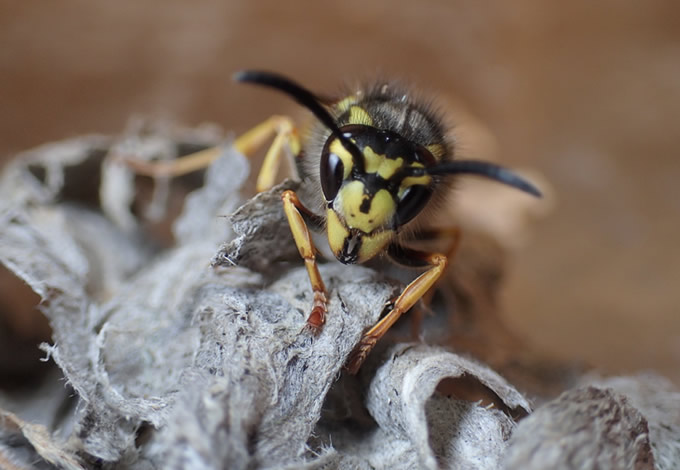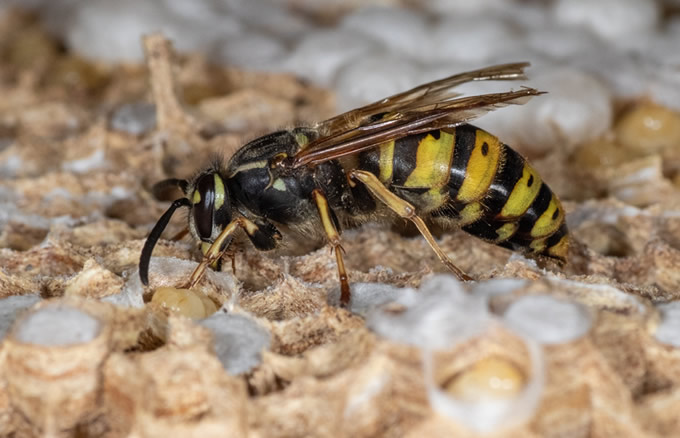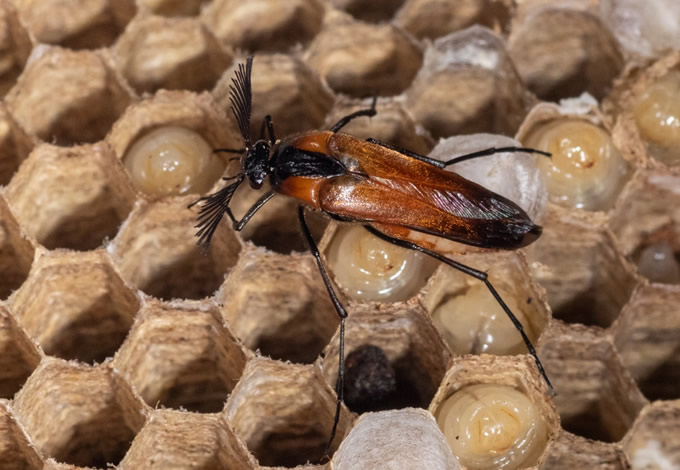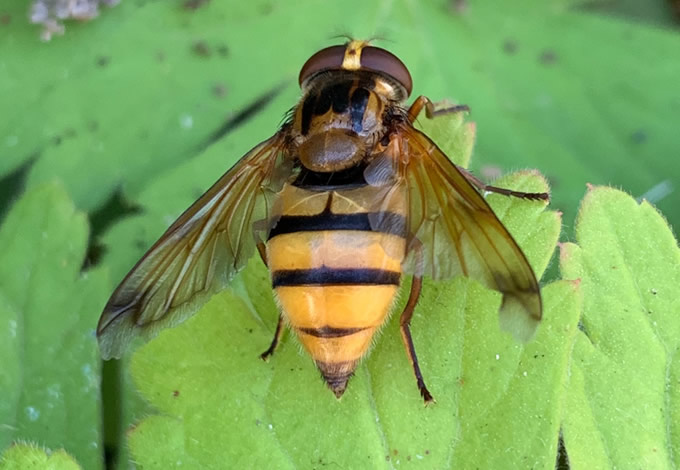Vespula species wasp application
An application is being prepared to introduce two biological control agents for the German wasp, Vespula germanica and the common wasp, V. vulgaris. Volucella inanis is a species of hoverfly that lays its eggs inside the nests of Vespula wasps and the larvae feed on wasp grubs. Metoecus paradoxus is a beetle whose larvae parasitise wasp grubs. German and common wasps are a major threat to the native biodiversity of New Zealand, and we expect these proposed biocontrol agents to negatively impact wasp numbers.

Background
This application will be submitted by the Tasman District Council on behalf of the Vespula Biocontrol Action Group. Manaaki Whenua – Landcare Research are providing the science, preparing the application and managing the application process, including consultation with EPA, Māori and other stakeholders.
The German Vespula germanica and common wasp V. vulgaris are eusocial wasps that can form very large colonies of several thousand individuals. Both species typically nest in holes in the ground, but nests are also found in rotten logs or stumps, in forest litter and in trees. In urban areas they nest in hollow walls, attics or aerial locations, for example under the eaves or hanging from rafters. Colonies of Vespula spp. have a caste system, with queens, workers and males (drones). The workers are responsible for collecting food, water and nesting material, caring for the brood and for nest defence. German wasp nests are grey and are constructed with fibres from structurally sound wood whereas nests of the common wasp are brown in colour, made from the pulp of rotting wood. German wasps have the capacity to maintain large overwintering nests whereas the common wasp colonies die in winter.

The German wasp is native to Europe and north Africa and was first confirmed as established in New Zealand at Te Rapa, Hamilton in 1945 (Thomas 1960). Recent phylogenetic research indicated that there have been at least two incursions of this species to New Zealand, with the largest population originating from the United Kingdom and a very small population originating from central Europe (Brenton-Rule et al 2018). The common wasp is native to Europe and parts of Asia (e.g. Pakistan and northern China). Queens of this species were first collected in Wellington in 1978 and nests were later found there in 1982 (Donovan 1984). A phylogenetic analysis indicated at least six incursions of the common wasp to New Zealand, originating from locations in the United Kingdom, Ireland, and Western Europe (Lester et al 2014). Following their introduction, both wasp species rapidly expanded their ranges and are now found throughout New Zealand, including Stewart Island (Clapperton et al. 1989b).
Beech forests at the top of the South Island have the highest densities of wasps in the world. Vespula wasps are generalist predators that attack a wide variety of arthropods including honeybees, butterflies, flies and spiders, but they will also scavenge for protein from animal carcasses and dustbins. They have detrimental effects on normal ecosystem functioning, food webs and the behaviour of native birds. The predation rate of wasps on native invertebrates is believed to be so high that some species are at risk of extinction (Toft and Rees, 1998). Studies have shown that up 13% of managed honeybee hives are destroyed annually (Clapperton 1989a), a significant impact on New Zealand’s bee keeping industry. Vespula wasps are intensely disliked by the New Zealand public through disrupting the enjoyment of the outdoors and recreational activities and the risk of stings, in severe cases leading to hospitalisation or even death. Both the German and common wasp are very destructive invasive pests that cost New Zealand up to $130 annually in damages and management (MacIntyre and Hellstrom, 2015).
More information about common and German wasps and their control can be found here.
Identification and assessment of risks, costs and benefits
The potential risks, costs and benefits associated with the proposed introduction of Volucella inanis and Metoecus paradoxus to New Zealand, and the expected reduction in the abundance of Vespula wasps have been identified by literature review and by consultation with stakeholders.
The application will address in detail the significant adverse and beneficial effects identified. The potential benefits of biological control will be the mitigation of the adverse effects of Vespula wasps. The key potential adverse effects relate to impacts of the biological control agents on native flora and fauna. These will be addressed fully in the application:
- the risk of direct damage to native insects
- indirect effects on flora and fauna as a result of disruption of ecological relationships
The wasp nest beetle, Metoecus paradoxus is a medium-sized beetle (8 – 12 mm) that parasitizes the brood of Vespula wasps. First instar larvae of M. paradoxus enter wasp nests after attaching themselves to the bodies of foraging Vespula wasps, and once inside, the larvae locate and consume one Vespula wasp grub each. Feeding continues until they are ready to pupate and they emerge as adults around the same time as their host would have completed its life cycle.

Volucella inanis also parasitizes the brood of Vespula species, but each larva attacks more than one wasp grub.The first instar V. inanis larva squeezes its way to the bottom of the brood cell of a large wasp grub and begins feeding on the posterior end of the grub. This severely compromises the wasp grub’s vitality. Second instar V. inanis larvae then seek a second wasp grub in the pre-pupal stage. Once the V. inanis larva locates an appropriate wasp grub, it makes its way to the bottom of the brood cell and waits for the wasp grub to close the cell with silk. Once the cell is sealed, the V. inanis larva feeds until it is ready to pupate, effectively killing the wasp grub.

Evidence that these agents are safe to introduce to New Zealand is strong. Through extensive literature review, we set out to identify species in the Hymenoptera (wasp, bee and ant order) with ecological similarities to the target wasp species. In New Zealand, the only insects that form social colonies, nest in cavities, or underground, are the introduced European honeybee (Apis mellifera) and the introduced bumblebees (Bombus spp.). Honeybees have been studied extensively in Europe for centuries and neither of the proposed biocontrol agents have ever been recorded in honeybee hives. One species of Volucella (V. bombylans) is known to parasitize bumblebee colonies in Europe. Host testing of V. inanis on Bombus terrestris in the native range, conducted by Manaaki Whenua showed that V. inanis larvae were not able to survive on B. terrestris brood. New Zealand does not have any native Hymenoptera species that have the same social behaviour or ecology of Vespula wasps. No additional tests of native insects or other valued species in New Zealand are required because there is a wealth of evidence available overseas indicating that these agents are safe to release here. This evidence will be considered by EPA when determining whether the biocontrol agents should be released here.
The EPA application will provide evidence that the proposed biological control agents for Vespula wasps will be host specific in New Zealand. Populations of the biocontrol agents may be detectable even if there are low populations of the target wasp species locally. Disturbance of ecological relationships in New Zealand is not expected to be significant. The expected benefits to New Zealand’s native fauna far outweigh any risks associated with potential non-target effects. These issues will be discussed in detail in the application.
Pre-application consultation with Iwi
The members of the EPA's national Māori network (Te Herenga) will be contacted in October 2019 and invited to enter dialogue on plans to apply to EPA to introduce biological control agents against Vespula wasps.
The message to Te Herenga will describe how the applicant intends to assess the risks, costs and benefits associated with the proposed introductions. Members will be invited to identify any issues that they would like to be addressed in the application. Further consultation will be coordinated through the Ngāpuhi HSNO komiti and the Ngāi Tahu HSNO komiti.
The responses specifically related to the proposed introduction of Vespula wasp biocontrol agents will be summarised here once available:
- Summary of Iwi responses (to come)
At the request of the applicant, EPA convened a reference group from Te Herenga to meet and discuss the issues surrounding the proposed applications. The application will address the principles identified in that report.
- Report of the reference group concerning biological control of wasps (to come)
Members of Te Herenga will be informed by EPA when the application is open for public submission and will be able to comment on how the applicant has addressed issues raised during consultation.
Pre-application consultation with other organisations
Other organisations to be consulted:
Consultation with South Island iwi
- Ngāi Tahu HSNO komiti
- Tasman District Council network
- Ngāti Toa Rangatira
- Te Atiawa o Te Waka-a-Māui
- Ngāti Apa ki te Rā Tō
- Rangitāne o Wairau
- Ngāti Kuia
- Ngāti Rārua
- Ngāti Kōata
- Ngāti Tama ki Te Tau Ihu
Te Herenga
Stakeholders
- Department of Conservation staff
- Regional Councils
- QEII National Trust
- NZ Landcare Trust
- Ecological Society of New Zealand Federated Farmers
- Royal Forest and Bird Protection Society of New Zealand
- NZ Entomological Society
- NZ Forest Owners Association
- Apiculture NZ
- District Health Boards
A summary of responses will be provided here once consultation is complete
- Summary of responses (to come)
Cited references
Brenton-Rule, E.C., Dobelmann, J., Baty, J.W., Brown, R.L., Dvorak, L., Grangier, J., Masciocchi, M., McGrannachan, C., Shortall, C.R., Schmack, J., van Zyl, C., Veldtman, R., Lester, P.J., 2018. The origins of global invasions of the German wasp (Vespula germanica) and its infection with four honeybee viruses. Biological Invasions.
Clapperton, B.K., Alspach, P.A., Moller, H., Matheson, A.G., 1989a. The impact of common and German wasps (Hymenoptera: Vespidae) on the New Zealand beekeeping industry. New Zealand Journal of Zoology 16, 325-332.
Clapperton, B.K., Möller, H., Sandlant, G.R., 1989b. Distribution of social wasps (Hymenoptera: Vespidae) in New Zealand in 1987. New Zealand Journal of Zoology 16, 315-323.
Donovan, B. J. (1984): Occurrence of the common wasp, Vespula vulgaris (L.) (Hymenoptera: Vespidae) in New Zealand, New Zealand Journal of Zoology, 11:4, 417-427.
Lester, P.J., Gruber, M.A.M., Brenton-Rule, E.C., Archer, M., Corley, J.C., Dvorak, L., Masciocchi, M., Van Oystaeyen, A., 2014. Determining the origin of invasions and demonstrating a lack of enemy release from microsporidian pathogens in common wasps (Vespula vulgaris). Diversity and Distributions 20, 964-974.
MacIntyre, P., Hellstrom, J., 2015. An evaluation of the costs of pest wasps (Vespula species) in New Zealand. Department of Conservation and Ministry for Primary Industries, Wellington, NZ, pp. 44.
Thomas, C. R. 1960. The European wasp (Vespula germanica Fab.) in New Zealand, New Zealand Department of Scientific and Industrial Research Information Series, Ser. 27
Toft, E., Rees, S. (1998). Restructuring of Lepidoptera communities by introduced Vespula wasps in a New Zealand beech forest. Oecologia 119, 565-571.
